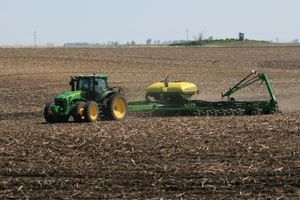Analysts Skeptical of USDA’s Planted Acreage Forecasts
 USDA estimated Tuesday that U.S. growers will plant 97 million acres of corn this spring, an 8% increase over 2019, but analysts say recent sharp declines in ethanol production make it doubtful that number will hold true.
USDA estimated Tuesday that U.S. growers will plant 97 million acres of corn this spring, an 8% increase over 2019, but analysts say recent sharp declines in ethanol production make it doubtful that number will hold true.
The surveys USDA used to make the estimate ended March 18, just before the ethanol market collapsed amid an oil price spiral and sharply decreased fuel usage due to the coronavirus pandemic travel restrictions, according to analyst Garrett Toay of Ag Trader Talk.
“It’s implying record western Corn Belt corn acres, 53.75 million acres in the western Corn Belt. The prior record is 52.46. million, and we did that in 2012 when it was hot and dry, we had planters running as hard as we could go and we got them planted,” Toay said on Tuesday’s Farm Journal Live webcast. “The other factor of that is that number also implies 3.4 million acres of corn-on-corn, and considering that what’s happening in the ethanol industry is being heavily weighted in the western Corn Belt, that number is obviously going to change between now and June.”
Soybean acres are projected by USDA at 83.5 million, a 10% increase over 2019. Toay expects the markets to try to buy another million acres or more for soybeans.
“We know historically we buy a million acres of beans between now and June, but I think what this market is going to try to do right now is try to buy an extra one to two million acres to try to get the bean acres up to two to three million from here, and then we’ll have a little bit more equilibrium in the markets,” Toay projected.
The overall increase in planted acres projected by USDA seems improbable, according to AgriTalk Radio’s Chip Flory, because of continued weather challenges for planting and the economics of the grain markets.
“One hundred eighty point five [million] combined corn and soybean [acres], that is a huge number.” Flory said. “A year ago it was 177.4, two years ago, I think it was 177. Economic conditions have not improved that dramatically in corn and soybean production to warrant that much of an increase in acres.”
Lance Honig, head of the Crops Division for USDA’s National Agricultural Statistics Service (NASS), however, says the data clearly shows farmers intend to return to normal planting patterns if they can and that the acres projected for 2020 are in line with actual planted acres for 2018 and earlier.
“We’re basically getting back, or at least the intentions are getting back, the acres that we couldn’t put in the ground last year,” Honig said on AgriTalk Radio. What it tells me is that as long as the weather cooperates and all things aside, that’s the plan is to get back to that, what I would call normal level over the last four or five years.”
Honig pointed out that over those same years, the difference between the March and June planted acres reports typically varied less than a million acres. Barring another weather anomoly, he said he expects 2020 to be the same.
On the grain stocks side, USDA lowered corn stocks 700 million bu. to 7.95 billion bu. and soybeans down 500 million bu. to 2.25 billion bu. in storage. Toay and Flory agree the corn stocks number indicates USDA may have overestimated the 2019 crop.
Source: John Herath, AgriMarketing
